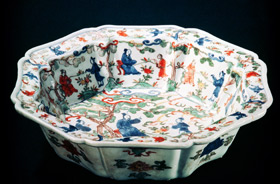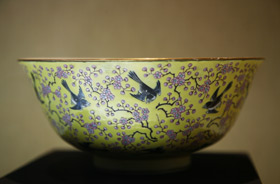|
 |
 |
|
A painted porcelain utensil of the Ming Dynasty (1368-1644) (CFP) |
A porcelain bowl of the Qing Dynasty (1644-1911) (CFP) |
Song, Yuan and early Ming dynasties witnessed the second peak of China's porcelain export. Products exported were mainly celadon ware from the Longquan Kiln and blue and white porcelain and underglaze red porcelain from the Jingdezhen Kiln. Chinese porcelain found a huge market in many countries in Asia and Africa at that time. Correspondingly, more than one sea route was established, leading to Northeastern and Southeastern Asia and the Persian Gulf in Western Asia.
In the early Ming Dynasty, the court issued a ban on unofficial maritime trade. But smuggling still became a new channel for ceramic exports during the middle period of the dynasty. During that time, European merchants, missionaries and diplomats began to set foot in China, and Portugal, the Netherlands and Britain established their own East India Companies one after another to engage in business. Chinese porcelain became so popular among royalty and nobility in Europe that statistics from Fu Zhenlun (1906-99), a well-known Chinese historian, show the Dutch East India Company alone, which came to the fore in fierce porcelain trade competition, transported 16 million pieces of Chinese porcelain to Europe from 1602 to 1682.
Despite the war during the last years of the Ming Dynasty and the ban on maritime trade re-imposed by the court of the Qing Dynasty, exports of porcelain continued in an underground form along the extended coastline of southeast China.
The 200-odd years from the middle and late Ming Dynasty to the early Qing Dynasty were a golden period for exports of Chinese porcelain. Typically, China's export porcelain was designed and decorated in Western style. Some were even painted with badges of families, companies or cities to meet specific demand of foreign buyers, which became known as "Armorial Porcelain." Chinese porcelain was exported in large quantities, even more than 1 million pieces each year.
During the reigns of emperors Kangxi, Yongzheng and Qianlong of the Qing Dynasty, porcelain exports hit an unprecedented record, as the maritime porcelain trade ban was finally lifted in 1684, triggering a new wave of exports. Statistics show in 1734, about 400,000 porcelain products were exported to the Netherlands, the same quantity of porcelain was transported to Britain in 1774, and from 1750 to 1781, the number of porcelain pieces exported to Sweden reached 1.1 million in total.
Archaeological findings in several sunken ancient merchant ships loaded with porcelain, found in recent years, have testified to the prosperity of porcelain export trade by sea in ancient China. At the same time, vast private and museum collections of Ming and Qing dynasties' porcelain in Europe provide corroborative evidence for booming porcelain exports in ancient China.
After the mid-Qing Dynasty, European countries drastically reduced imports of Chinese porcelain, because of the rapid growth of their own ceramic industries. Furthermore, since the Opium War in 1840, both Europe and Japan poured machine-made porcelain products into China, putting an end to the history of Chinese porcelain exporting.
The author is a research fellow with the Department of Cultural Relics of the Administrative Office of the Summer Palace |
